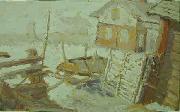La Peinture à l'huile en gros de Chine & Encadre |
|||||||||||

|
|||||||||||
|
|
|
||||||||||||||
|
Joel Pettersson
(June 8, 1892 - January 5, 1937) was a painter and writer on the Åland Islands, Finland. He remained an obscure figure during his lifetime; most of his works were unpublished for decades after his death. Pettersson was born into poverty in Lemland, Åland. His parents were elderly peasants, Joel's father being well over 50 at the time of Joel's birth. Joel had a younger brother Karl, who died at sea in 1916. Pettersson began writing and painting in his early school years, though much of his works from this period were not preserved. In 1913, he had the opportunity to study at a drawing school in Turku. He stayed in Turku until 1915, when he decided to abort his studies and return to Åland. He painted for a few years, but he eventually tired of it and did not paint for many years. Upon his return, Pettersson became active in the local youth organisation, for which he wrote plays and monologues. He also wrote prose which he read out loud during organisation meetings. Pettersson was most active as a writer following his return from Turku until 1921. During the 1920s, Pettersson worked mostly on his parents' farm, only sporadically participating in the youth organisation's activities. His parents both died in 1928, leaving Pettersson to care for the farm. He sold all the animals and most of the property. He tried earning a living on his artistry, but was unsuccessful. He then tried raising hens, but this also proved to be an unsuccessful venture. He resumed painting in 1935, and some of his paintings were displayed during an exhibition the following year. His constant economic difficulties and work load took their toll. In 1936, he suffered a nervous breakdown and was committed to Grelsby Asylum, where he remained until his death in early 1937. |
||||||||||||||
|
|
||||||||||||||
|
||||||||||||||
|
|
||||||||||||||
| Joel Pettersson
(June 8, 1892 - January 5, 1937) was a painter and writer on the Åland Islands, Finland. He remained an obscure figure during his lifetime; most of his works were unpublished for decades after his death. Pettersson was born into poverty in Lemland, Åland. His parents were elderly peasants, Joel's father being well over 50 at the time of Joel's birth. Joel had a younger brother Karl, who died at sea in 1916. Pettersson began writing and painting in his early school years, though much of his works from this period were not preserved. In 1913, he had the opportunity to study at a drawing school in Turku. He stayed in Turku until 1915, when he decided to abort his studies and return to Åland. He painted for a few years, but he eventually tired of it and did not paint for many years. Upon his return, Pettersson became active in the local youth organisation, for which he wrote plays and monologues. He also wrote prose which he read out loud during organisation meetings. Pettersson was most active as a writer following his return from Turku until 1921. During the 1920s, Pettersson worked mostly on his parents' farm, only sporadically participating in the youth organisation's activities. His parents both died in 1928, leaving Pettersson to care for the farm. He sold all the animals and most of the property. He tried earning a living on his artistry, but was unsuccessful. He then tried raising hens, but this also proved to be an unsuccessful venture. He resumed painting in 1935, and some of his paintings were displayed during an exhibition the following year. His constant economic difficulties and work load took their toll. In 1936, he suffered a nervous breakdown and was committed to Grelsby Asylum, where he remained until his death in early 1937. Grinden, Grinden, Oil painting cjr Grinden, Oil painting cjr |
||||||||||||||
|
Related Paintings to Joel Pettersson :. |
||||||||||||||
|
|
||||||||||||||
|
|
||||||||||||||
|
CONTACTER DES Etats-Unis |







